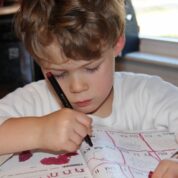
Literacy
1. Literacy Rich Environment: The biggest teaching reading advice I can give parenting of pre-schooler, is to have a literacy rich environment for your kids. Have books easy to grab and read if you have a few minutes. Play games that encourage phonetic awareness. My second child thrived on games and seriously about 90% of his pre-school education was game related. Here are some other ideas I do with my kids:
2. Don’t Stop Reading to Your Child: Studied show that reading to your child is one of the best things you can do to help them become a better reader. Don’t stop when your child can read on his / her own. Choose a story that is above his/her reading level and continue reading with them. Make reading habits with your kids. We always start the day with reading the children’s Bible together and end the day with a story of their choice. There are usually many other books in between but the habitual reading I always know is going to happen.
3. Visualize and Verbalizing: One of the best reading comprehension strategies that I came across in my program work for my Master’s degree was this strategy. Poor readers do not visualize when they read. There is no picture in their mind, instead they are just “word calling.” These types of readers need help learning how to visualize while reading. To do this, engage your child in the story. Make prediction and talk about what you think the characters or setting could look like. Bring the stories to life. As you read you may have to adapt your previous “picture” to fit with the new information. In the beginning you will need to stop every sentence or so and ask visualizing questions (What does the spider look like? What color? What size? What kind of spider? Is it a real life looking spider in your mind or a cartoonish spider? What kind of web is it in? Where is the web? What kind of building? Are there any other animals in your picture?) You could ask ALL of those questions for the sentence: The spider built a web. It takes a while but it really helps to make readers who “see” the stories they read and thus comprehend things much better. Try it!
4. Journal with your Kids: Not only does this activity encourage writing, spelling and reading, it also provides you with a journal of your child’s thoughts for years to come. I use the marble composition notebooks because they are cheap and durable. Write your child’s name on the front and leave him/her a message she can read. Draw pictures for words she can’t read. Start simple. Ask questions. When your child writes back, respond. It is a great way to get to know what is on your child’s mind. Keep the journals right by their bed. I allow my children to read or write in the journals after they are tucked in. This is also a great tool for getting older children to open up about things they may not feel comfortable saying.
5. Phonics: Here are some suggestions of things to do with your preschoolers to help them with their phonemic awareness:
- Have flash cards in the car (site words) and look for letters outside when you are driving.
- The Leap Frog Movies are fabulous: The Letter Factory, Talking Words Factory and Let’s Get Ready for School are great for beginning phonics and reading.
- Using play dough make as many “snakes” as you need to make a letter (3 for the capital A). Give the “snakes” to your child and show him/her how to make an A. Then have him/her do it on his/her own. Say the sound as you are making the letter.
- Fill a Ziplock bag with glue and a drop or two of food coloring, and seal it tight. Have your child make letters in the glue. Say the letter sound.
- Keep a Tupperware of salt. Trace letters in the salt. Say the letter sound.
- Cut out letters on sandpaper. Have your child trace the letter with his/her finger. Say the letter sound.
- Put a piece of plain paper on top of a plastic needlepoint plastic sheet (It has tiny squares). With a crayon print hard whatever letters you want your child to work on. Have your child trace the letters with his/her finger. Say the letter sound.
- Hide letters and have your child find them and say the name and sound.
- Place letters on the floor and run from letter to letter until the music turns off (or someone yells STOP). Then everyone says their letter and sound. You can do this with colors, shapes and numbers too.
- Have a word wall in your house.
- Hang white board for messages on your kid’s doors.
- Buy foam letters for the tub.
- Fridge Phonics (Leap Frog) for the kitchen.
- Eat through the alphabet. We have a yummy and yucky wall that we put the food words on.
- Make ABC books on the attributes of God, Bible characters and words or animals, etc. Print the pages, color them and make a little booklet.
- Games I love: Boggle Jr, Alphabet Bingo, Scrabble Jr, ABSeas, Go Fish ABCs
- So many great pre-school computer programs and apps for literacy. Some that we have used are Reading Eggs, ABC Mouse and EasyPeasyHomeschool.

